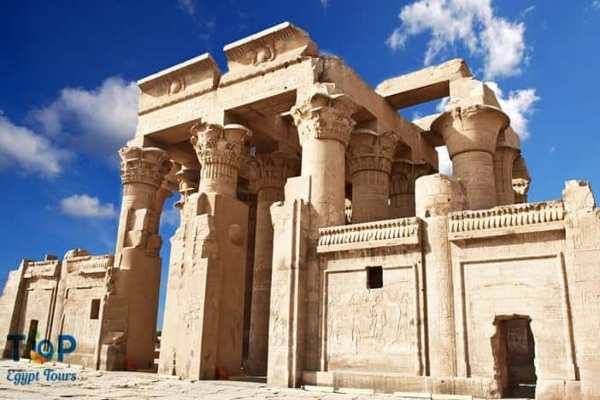Kom Ombo Temple, also known as the Temple of Sobek and Horus, is a unique double temple located in the town of Kom Ombo in Aswan Governorate, Upper Egypt. The temple was constructed during the Ptolemaic dynasty, 180–47 BC. Some additions to it were later made during the Roman period.
The temple is dedicated to two deities: the crocodile god Sobek, god of fertility and creator of the world with Hathor and Khonsu, and the falcon god Horus, god of the sky and kingship. The temple’s unique double design reflects this duality, with each half of the temple dedicated to one of the gods.
In this article, we will uncover for you the Temple of Sobek and Horus with Top Ten Egypt.
Architectural Splendor Of Kom Ombo Temple:
The Temple of Sobek and Horus is a marvel of ancient Egyptian architecture. The temple complex features towering sandstone pylons, imposing columns, and intricately carved reliefs. The temple’s entrance, adorned with colossal statues and decorated pylons, creates a majestic gateway that transports visitors into the world of ancient Egypt.
Inside the temple complex, visitors can admire the grand courtyard, hypostyle hall, and sanctuary. The courtyard is surrounded by colonnades, and its walls are adorned with reliefs depicting scenes from the Sobek and Horus myths. The hypostyle hall is a vast chamber supported by massive columns. The sanctuary is the innermost chamber of the temple, where the statues of Sobek and Horus were once housed.
Historical Significance:
Kom Ombo Temple was an important religious center during the Ptolemaic and Roman periods. It was a place of pilgrimage for people from all over Egypt, who came to seek Sobek’s and Horus’s blessings. The temple was also a center of learning, and its priests were skilled in astronomy, mathematics, and medicine.
The temple is also significant for its unique double design. It is one of the only double temples in Egypt that is still standing. The temple’s double design reflects the duality of Sobek and Horus, and it is a testament to the religious tolerance of the Ptolemaic period.
Cultural Heritage Preservation Temple of Sobek and Horus:
Kom Ombo Temple was buried in sand for centuries, and it was not until the 19th century that it was excavated by French archaeologists. The temple was carefully restored, and it is now one of the most popular tourist attractions in Egypt.
The Egyptian government has taken steps to preserve Kom Ombo Temple for future generations. The temple complex is surrounded by a buffer zone to protect it from development, and regular maintenance and restoration work is carried out to ensure that the temple remains in good condition.
Artistic Treasures:
Kom Ombo Temple is adorned with exquisite reliefs and hieroglyphics. The reliefs depict scenes from the Sobek and Horus myths, as well as religious rituals and historical events. The hieroglyphics provide insights into the religious beliefs and practices of the Ptolemaic and Roman periods.
Some of the most notable artistic treasures at Kom Ombo Temple include:
- The relief on the entrance pylon depicting Ptolemy VI Philometor offering gifts to Sobek and Horus.
- The relief on the north wall of the courtyard depicts the birth of Horus.
- The reliefs on the walls of the hypostyle hall depict religious rituals and historical events.
- The hieroglyphic inscriptions on the walls of the sanctuary.
Cultural Experience and Connection:
A visit to Kom Ombo Temple offers visitors a unique opportunity to experience the ancient Egyptian culture. The temple’s grand architecture, intricate reliefs, and hieroglyphics transport visitors to a bygone era.
Visitors can learn about the religious beliefs and practices of the Ptolemaic and Roman periods, and they can gain a deeper appreciation for the artistic achievements of ancient Egypt. Kom Ombo Temple is also a reminder of the rich cultural heritage that Egypt shares with the world.
Kom Ombo Temple is a must-see for any visitor to Egypt. It is one of the most unique and well-preserved ancient Egyptian temples in the world. The temple complex offers a unique glimpse into the religious beliefs, cultural practices, and artistic achievements of ancient Egypt.
Unveil the mysteries of ancient Egypt with an Aswan Day Tour and Aswan Day Tour To Kom Ombo and Edfu Temples that include a visit to the extraordinary Kom Ombo Temple.
Browse our complete list of Egypt tours.



Comment (0)